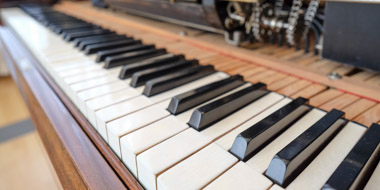Sound recordings

 l
l
In fulfilment of its legal mandate, the German Music Archive collects two copies of all the sound recordings released in Germany. One is kept in Leipzig, the other is archived by the German National Library at its location in Frankfurt am Main. The stacks provide ideal storage conditions for CDs, records and cassettes. You can access the musical content of our CDs and many of our analog sound carriers at the computers in the library building. Older sound carriers no longer protected by copyright can also be retrieved outside the library. As a result of digitalising analog sound carriers and migrating CDs, our reading rooms now provide access to more than 500,000 hours of music from all genres.
Historic sound recordings

CDs dying out? Records coming back in? The world of sound carriers is remarkably diverse. One format has replaced another ever since the early days of sound recording in the late 19th cen-tury. Some media even seem to date from a completely different era. Would you have thought that colourful plastic records were already available in the 1920s?
However, wax cylinders, shellac records and rolls for self-playing pianos were far more com-mon. The German Music Archive has several thousands of these sound recordings. They reflect an important segment of the music market during the first half of the 20th century. You can marvel at these and many other sound recording milestones in the exhibition “From Edison Cylinder to Blu-ray” in the foyer of the German Music Archive.
Please contact us (info-dma@dnb.de) if you find a work in our catalogue that is on record (whether vinyl or shellac) but has not yet been digitised. We will then make a digitised version of the recording available to you.
Emile Berliner's first records
 Photo: Stephan Jockel
Photo: Stephan Jockel
Between 1999 and 2005, the German Music Archive acquired around 1,000 records produced by Emile Berliner. Emile Berliner is considered the inventor of the record and patented his recording and playback processes in 1887. The recordings we have acquired date from 1898 to 1901; produced after Emile Berliner had spent a considerable amount of time experimenting with material, recording processes, duplication, recording speeds etc., they are some of the first records ever traded commercially. Most of the recordings were made in Europe, some in New York and St. Petersburg.
They are important cultural artefacts that testify to the remarkable speed of record development in its early days. Ten different versions of the label design were created over a period of just three years.
All of these very different records (their size ranges from five to ten inches) are now available in digital format. Because of the diversity of the materials and the lack of information about playback speeds, the digitisation of the recordings proved to be very challenging. We were able to clarify the rights for 730 of the records – users all over the world can now listen to them online through the German National Library's catalogue.
Last changes:
05.01.2024
Short-URL:
https://www.dnb.de/tontraeger
Contact:
info-dma@dnb.de





